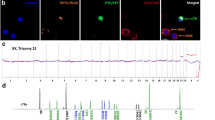Summary
The single cell isolation technique was used to detect fetal nucleated erythroblasts (FNR-BCs) at a single cell level from the peripheral blood of pregnant women in order to investigate the feasibility of this method for noninvasive prenatal diagnosis. Single fetal nucleated erythroblasts were isolated from the peripheral blood samples from 51 pregnant women (14 to 26 weeks of gestation) by micromanipulation techniques after density gradient centrifugation. Nested polymerase chain reaction method was used to amplify the SRY gene. It was found that the concordance rate of amplification results with real fetal sex was 82.61 %. The sensitivity and specificity were 80 % and 87.50 % respectively. It was suggested that it is feasible and promising in non invasive prenatal diagnosis to detect fetal nucleated erythroblasts at a single cell level by using micromanipulation techniques.
Similar content being viewed by others
References
Kuo P L. Frequencies of fetal nucleated red blood cells in maternal blood during different stages of gestation. Fetal Diagn Ther, 1998, 13(6): 375
Bianchi D W, Zickwolf G K, Yih M Cet al. Erythroidspecific antibodies enhance detection of fetal nucleated erythrocytes in maternal blood. Prenat Diagn, 1993, 13: 293
Steele C D, Wapner R J, Smith J Bet al. Prenatal diagnosis using fetal cells isolated from maternal peripheral blood: a review. Clin Obstet Gynecol, 1996, 39(4):801
1999, 16(3):191
Ganshirt D, Smeets F W, Dohr Aet al. Enrichment of fetal nucleated red blood cells from the maternal circulation for prenatal diagnosis experiences with triple density gradient and MACS based on more than 600 cases. Fetal Diagn Ther, 1998, 13(5):276
Watanabe A, Sekizawa A, Taguchi Aet al. Prenatal diagnosis of ornithine transcarbamylase deficiency by using a single nucleated erythrocyte from maternal blood. Hum Genet, 1998, 102(6):611
Bianchi D W, Zickwolf G K, Weil G Jet al. Male fetal progenitor cells persist in maternal blood for as long as 27 years postpartum. Pro Natl Acad Sci USA, 1996, 93 (2): 905
Hamada H, Arimami T, Hamaguchi Het al. Fetal nucleated cells in maternal peripheral blood after dilivery. Am J Obstet Gynecol, 1994, 170:1188
Takababyshi H, Kwabara S, Ukita Tet al. Development of noninvasive fetal DNA diagnosis from maternal blood. Prenat Diagn, 1995, 15(1): 74
Di Naro E, Ghezzi F, Vitucci Aet al. Prenatal diagnosis of beta-thalassamia using fetal erythroblasts enriched from maternal blood by a novel gradient. Mol Hum Reprod, 2000, 6(6):571
Author information
Authors and Affiliations
Additional information
This project was supported by a grant from Science Foundation of Ministry of Public Heath of China (No. 96. 2-112) and a grant from Hubei Provincial National Natural Science Foundation (96J068).
Rights and permissions
About this article
Cite this article
Taoran, W., Hanping, C., Yunping, L. et al. Y specific sequence gene analysis of single fetal nucleated erythroblasts from the peripheral blood of pregnant women. Current Medical Science 21, 163–165 (2001). https://doi.org/10.1007/BF02888086
Received:
Published:
Issue Date:
DOI: https://doi.org/10.1007/BF02888086




